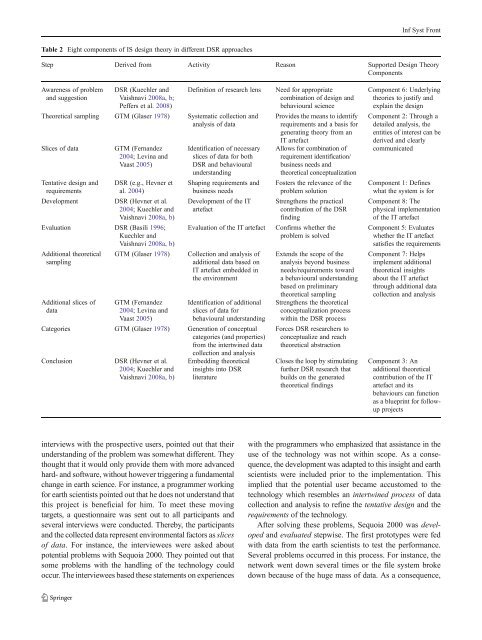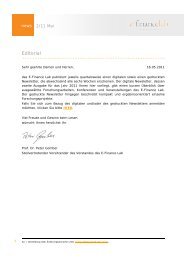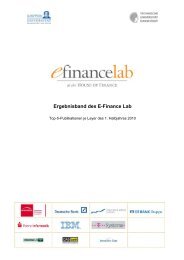Prof. Dr. Wolfgang König, Prof. Dr.-Ing. Ralf ... - E-Finance Lab
Prof. Dr. Wolfgang König, Prof. Dr.-Ing. Ralf ... - E-Finance Lab
Prof. Dr. Wolfgang König, Prof. Dr.-Ing. Ralf ... - E-Finance Lab
Create successful ePaper yourself
Turn your PDF publications into a flip-book with our unique Google optimized e-Paper software.
Table 2 Eight components of IS design theory in different DSR approaches<br />
Step Derived from Activity Reason Supported Design Theory<br />
Components<br />
Awareness of problem<br />
and suggestion<br />
DSR (Kuechler and<br />
Vaishnavi 2008a, b;<br />
Peffers et al. 2008)<br />
Theoretical sampling GTM (Glaser 1978) Systematic collection and<br />
analysis of data<br />
Slices of data GTM (Fernandez<br />
2004; Levina and<br />
Vaast 2005)<br />
Tentative design and<br />
requirements<br />
DSR (e.g., Hevner et<br />
al. 2004)<br />
Development DSR (Hevner et al.<br />
2004; Kuechler and<br />
Vaishnavi 2008a, b)<br />
Evaluation DSR (Basili 1996;<br />
Kuechler and<br />
Vaishnavi 2008a, b)<br />
Additional theoretical<br />
sampling<br />
Additional slices of<br />
data<br />
interviews with the prospective users, pointed out that their<br />
understanding of the problem was somewhat different. They<br />
thought that it would only provide them with more advanced<br />
hard- and software, without however triggering a fundamental<br />
change in earth science. For instance, a programmer working<br />
for earth scientists pointed out that he does not understand that<br />
this project is beneficial for him. To meet these moving<br />
targets, a questionnaire was sent out to all participants and<br />
several interviews were conducted. Thereby, the participants<br />
and the collected data represent environmental factors as slices<br />
of data. For instance, the interviewees were asked about<br />
potential problems with Sequoia 2000. They pointed out that<br />
some problems with the handling of the technology could<br />
occur. The interviewees based these statements on experiences<br />
Definition of research lens Need for appropriate<br />
combination of design and<br />
behavioural science<br />
Identification of necessary<br />
slices of data for both<br />
DSR and behavioural<br />
understanding<br />
Shaping requirements and<br />
business needs<br />
Development of the IT<br />
artefact<br />
Provides the means to identify<br />
requirements and a basis for<br />
generating theory from an<br />
IT artefact<br />
Allows for combination of<br />
requirement identification/<br />
business needs and<br />
theoretical conceptualization<br />
Fosters the relevance of the<br />
problem solution<br />
Strengthens the practical<br />
contribution of the DSR<br />
finding<br />
Evaluation of the IT artefact Confirms whether the<br />
problem is solved<br />
GTM (Glaser 1978) Collection and analysis of<br />
additional data based on<br />
IT artefact embedded in<br />
the environment<br />
GTM (Fernandez<br />
2004; Levina and<br />
Vaast 2005)<br />
Identification of additional<br />
slices of data for<br />
behavioural understanding<br />
Categories GTM (Glaser 1978) Generation of conceptual<br />
categories (and properties)<br />
from the intertwined data<br />
Conclusion DSR (Hevner et al.<br />
2004; Kuechler and<br />
Vaishnavi 2008a, b)<br />
collection and analysis<br />
Embedding theoretical<br />
insights into DSR<br />
literature<br />
Extends the scope of the<br />
analysis beyond business<br />
needs/requirements toward<br />
a behavioural understanding<br />
based on preliminary<br />
theoretical sampling<br />
Strengthens the theoretical<br />
conceptualization process<br />
within the DSR process<br />
Forces DSR researchers to<br />
conceptualize and reach<br />
theoretical abstraction<br />
Closes the loop by stimulating<br />
further DSR research that<br />
builds on the generated<br />
theoretical findings<br />
Inf Syst Front<br />
Component 6: Underlying<br />
theories to justify and<br />
explain the design<br />
Component 2: Through a<br />
detailed analysis, the<br />
entities of interest can be<br />
derived and clearly<br />
communicated<br />
Component 1: Defines<br />
what the system is for<br />
Component 8: The<br />
physical implementation<br />
of the IT artefact<br />
Component 5: Evaluates<br />
whether the IT artefact<br />
satisfies the requirements<br />
Component 7: Helps<br />
implement additional<br />
theoretical insights<br />
about the IT artefact<br />
through additional data<br />
collection and analysis<br />
Component 3: An<br />
additional theoretical<br />
contribution of the IT<br />
artefact and its<br />
behaviours can function<br />
as a blueprint for followup<br />
projects<br />
with the programmers who emphasized that assistance in the<br />
use of the technology was not within scope. As a consequence,<br />
the development was adapted to this insight and earth<br />
scientists were included prior to the implementation. This<br />
implied that the potential user became accustomed to the<br />
technology which resembles an intertwined process of data<br />
collection and analysis to refine the tentative design and the<br />
requirements of the technology.<br />
After solving these problems, Sequoia 2000 was developed<br />
and evaluated stepwise. The first prototypes were fed<br />
with data from the earth scientists to test the performance.<br />
Several problems occurred in this process. For instance, the<br />
network went down several times or the file system broke<br />
down because of the huge mass of data. As a consequence,








